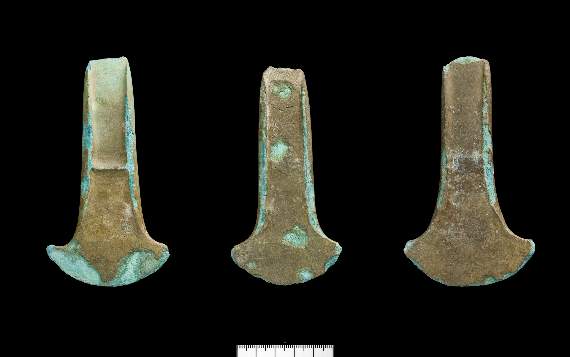Other archaeological finds within the county include Roman coins and medieval jewellery.
AN Early Bronze Age hoard of axes found in Monmouthshire was declared treasure yesterday (21st July 2016) by H.M. Coroner for Gwent.
The hoard was discovered by Mr Peter Shephard in Llanover in August 2014 while the finder was metal-detecting in a field used as rough pasture.
The discovery was first reported to Dr Mark Lewis via the National Roman Legion Museum at Caerleon and was subsequently reported on by museum archaeologists based at the National Museum Cardiff.
The hoard contains three near complete flanged axes of bronze and may be dated to the Arreton phase of the Early Bronze Age, around 1750-1500 BC or 3,750-3,500 years ago.
Two of the axes were found directly associated, while the third was found three to four metres away from the first two. It is probable that all three axes were once buried together as a single hoard in a pit, one of the axes having been disturbed and moved at some time since burial.
Archaeologists now think that these complete and prized bronze objects were probably buried during a ritual ceremony, perhaps gifted to the gods. Many Bronze Age hoards haven been discovered across Britain and Europe, so this discovery fits into a much wider picture of hoarding practice as an expression of early beliefs.
National Museum Wales is keen to acquire this hoard for the national collections following its independent valuation. It hopes to acquire the hoard with grant funding provided through the Saving Treasures; Telling Stories project, funded via the Collecting Cultures stream of the Heritage Lottery Fund.
Adam Gwilt, Principal Curator of Prehistory at National Museum Wales said: “These axes provide important new information about the development and use of bronze tools in south-east Wales towards the end of the Early Bronze Age.
“One of the axes is more technologically advanced than the other two, with a defined stop across the middle of the axe. This would have improved the way a wooden handle or haft was secured to the blade, so it could be used as a wood-cutting and working tool.”
Further discoveries declared as treasures in Monmouthshire are as follows:
A small Roman hoard of 21 coins called ‘radiates’, dating to the late third century AD, was found by Mr Dominic Rapley and Mr Mark Rogers in Llanarth.
Examination of the surfaces of the coins under a microscope by an archaeological conservator revealed the mineralised traces of textile on one coin. This suggests that the small hoard of coins was buried in a cloth bag. Abergavenny Museum are keen to acquire this find for its collections.
A fragment of silver gilt finger ring found by Mr Russell Peach in Caerwent. The form of the ring is thirteenth or fourteenth century. National Museum Wales are keen to acquire this finger ring.
A silver gilt pin was found by Mr L. Booth at Mitchell Troy in 2013. Its spherical head is decorated with twisted wire forming six circlets on each hemisphere.
This type of pin is now generally recognised as being of sixteenth-century date.
A silver medieval brooch frame was found by Mr Delwyn James Samuel at Llangattock-Vibon-Avel. One face is decorated with a herringbone pattern; the other has parallel transverse lines for half of the circumference, and a crude zig-zag for the remainder, while there are traces of black niello within the incised lines.
This form of decoration is typical of the thirteenth and fourteenth centuries. Abergavenny Museum wishes to acquire this item for its collections.
A Tudor silver gilt dress-hook was found at Grosmont, by Mr E. Harvey. A back-plate supports a hollow, cast heart-shaped boss, decorated with filigree ornament of circlets within larger circles, and raised silver pellets.
This is the first example of this particular form of dress hook to be recorded from Wales, but a close parallel dated to the sixteenth century is known from New Romney, Kent.
Other dress hooks have been found at various locations across England and Wales, illustrating the widespread popularity of these accessories.
All of these treasure discoveries will be acquired for museums in Wales with grant funding provided by the Saving Treasures; Telling Stories project, funded via the Collecting Cultures stream of the Heritage Lottery Fund.
Archaeological treasures from Wales and around the world can be seen at National Museum Cardiff in the Treasures: Adventures in Archaeology exhibition which is open until October.

Comments
This article has no comments yet. Be the first to leave a comment.